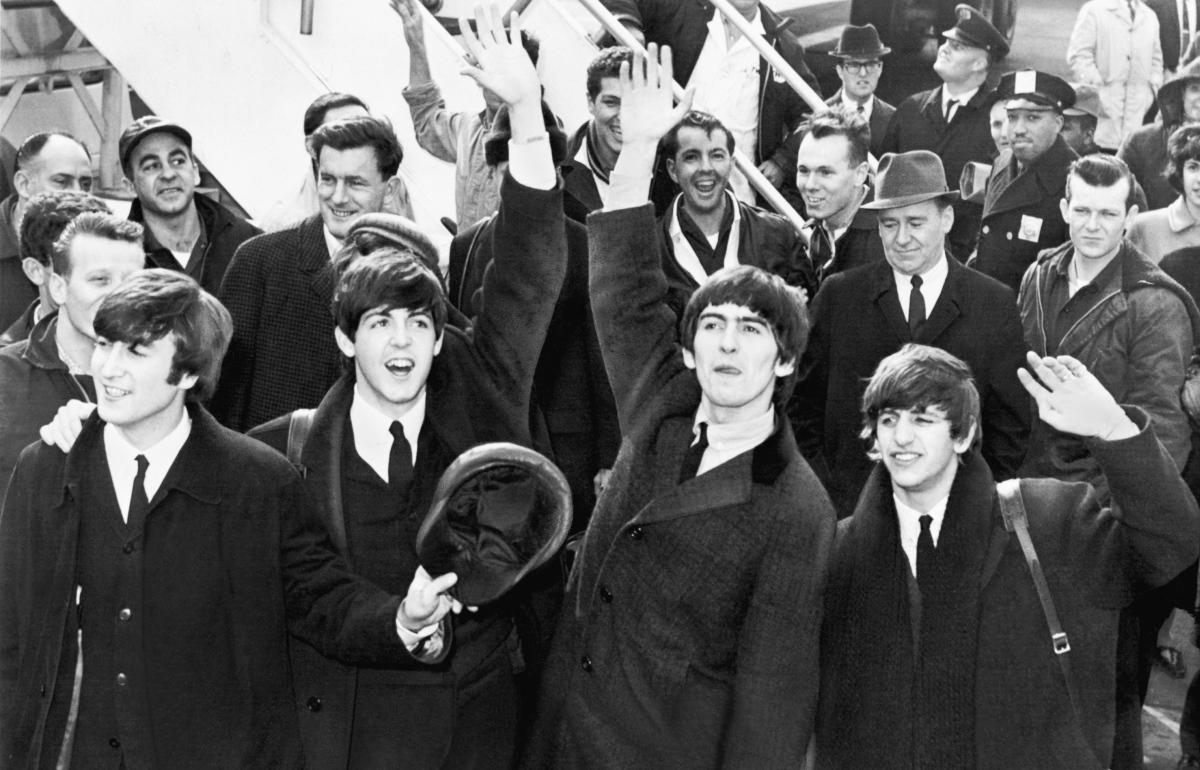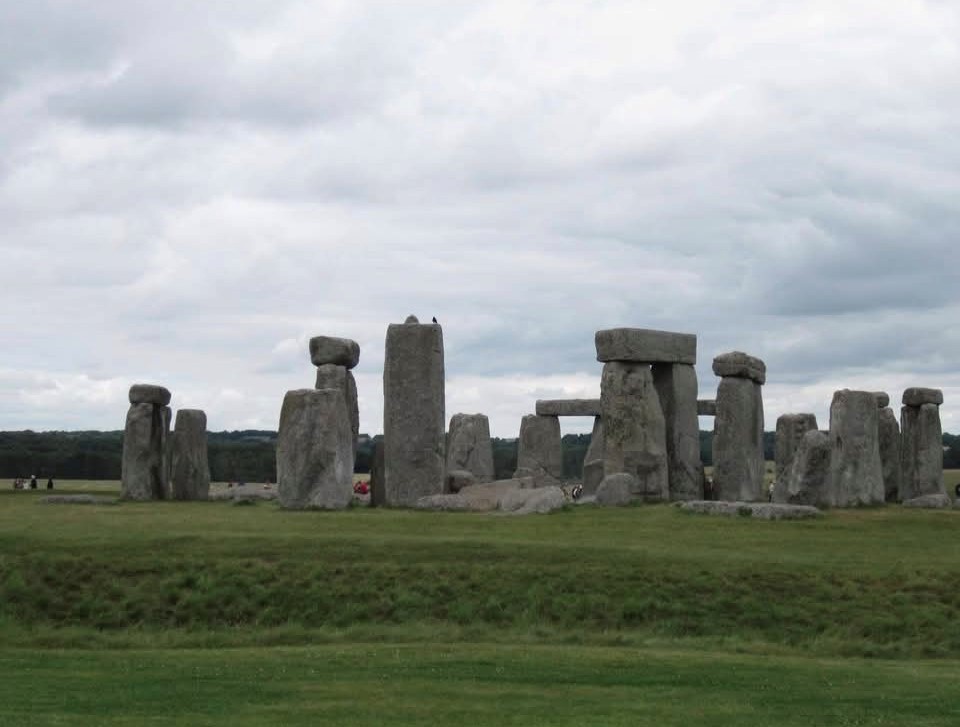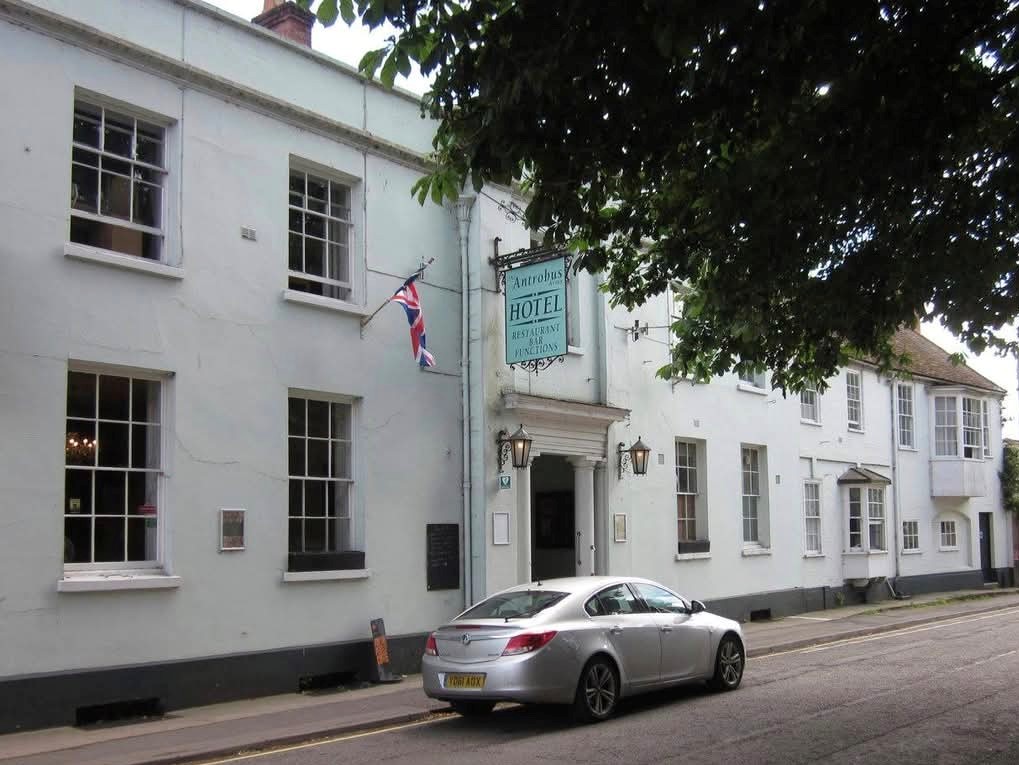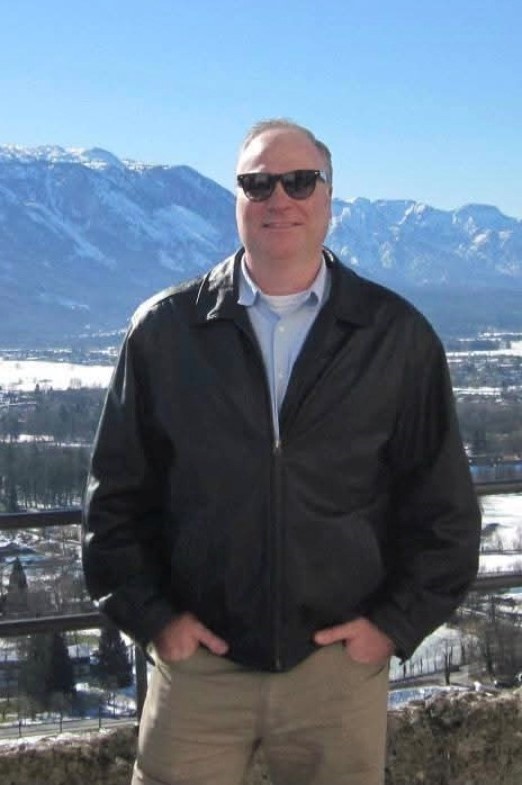
The Beatles arrive in New York City in 1964 a year before releasing the movie “Help!” (Photo: Library of Congress)
The Beatles were on a roll in 1964 and sought to extend their brand from music to film, taking the Fab Four on a bizarre ride that etched a new chapter in their burgeoning careers.
Their first film, musical comedy “A Hard Day’s Night” in 1964, was a huge success despite a thin plot, and they immediately started working on second picture, tentatively titled “Eight Arms to Hold You.”
Even ardent Beatles fans may not recall the title — because the name was ultimately changed to “Help!”
Now 60 years after its release, the film is part of the band’s iconography and symbolizes the innocence of early pop music before the arrival of sex, drugs, rock ‘n roll and the psychedelic sounds of the counterculture.
Click Here To Watch Help! The Beatles’ Iconic 1965 Movie!
Of course, one of the best parts of the movie is the music, and the “Help!” album showcased the Beatles growth as a band. The movie also marked a turning point. The band established their independence afterward and began charting their own course.
But in 1965, The Beatles were still their comedic, zany selves and “Help!”reflected the band’s image as carefree Liverpool lads who were somewhat overwhelmed by their sudden fame.
The plot was hatched as a parody of James Bond spy films, which ruled the box office starting with “Dr. No’s” debut in 1962 through two successive films, “From Russia With Love,” (1963) and “Goldfinger” (1964).
“Help!’s” simple storyline revolves around Beatles drummer Ringo and a golf ball-sized, sacred red ring mailed to him by a mysterious woman. A Far-Eastern cult lays claim to it and wants it back, but Ringo can’t get it off his finger.
The Fab Four are in the middle of a tour when the eastern thugs show up, causing them to flee London for the Salisbury Plain, the Austrian Alps, and the beaches of the Bahamas. Plausible? Of course not. Fun? That was the point.
Even if you don’t like the lightweight plot, the rich visuals are a treat and the film acts as a mid-60s time capsule. Thanks to the success of the first film, it was also shot in color and is credited with being a template for the music video era.
Each song’s sequence is cut like a modern-day music video and could have stood alone in the rotation on MTV, back when the channel played music videos.

The Beatles stayed near Stonehenge while filming “Help!” (Photo: Matt Kindelmann)
I also appreciate the satire of the James Bond series, the comic nods to The Goon Show and the Marx Brothers.
“A hell of a lot of pot was being smoked while we were making the film. It was great. That helped make it a lot of fun,” Ringo said. George admitted that they were smoking marijuana on the plane ride all the way to the Bahamas, which may account for some of the outlandishness.
Songs on the first side are from the film. Though the title track was penned to gratify the obligations of the film, the song is a personal declaration about being suffocated by fame and John feeling trapped in his marriage.
“Subconsciously, I was crying out for help,” John said later.
I like the self-consciousness and admire the fact that “Help!” is a deep song disguised as a pop tune.
I like the call and response of Paul’s “The Night Before” and the superb cadences George uses on the volume pedal of “I Need You.”
“You’ve Got To Hide Your Love Away” is another example of the increasing influence of Bob Dylan upon John’s songwriting.
“You’re Going to Lose That Girl” and “Another Girl” are straightforward tuners, but still charming.
“Ticket to Ride’s” drums and coda bring to mind the boys stumbling through the snow and singing around a baby grand atop an Austrian slope.

The Beatles checked into the Antrobus Arms Hotel in Amesbury, England while filming. The hotel is virtually unchanged today. (Photo: Matt Kindelmann)
The album’s second side — Ringo’s hokey “Act Naturally,” the lightweight “It’s Only Love” and George’s “You Like Me Too Much — were recorded in the late winter and early spring of 1965.
I agree with Paul when he described “Tell Me What You See” as “not awfully memorable,” but his folksy “I’ve Just Seen A Face” evokes the vibe of love at first sight.
Hidden deep inside two right before the closer is “Yesterday,” the Beatles’ best song of the album and their most mature song up until that time.
“Dizzy Miss Lizzy,” the last rollicking cover the band released harkens back to the sweaty Cavern days in Liverpool, and closes the album on a pure rock and roll note.
About a third of the Help! was filmed at Twickenham Studios and in different exterior locations around London in the spring of 1965.
Though it looks like it was shot on location in Austria, the soundtrack’s cover, which shows the Beatles with their arms positioned to spell out what one would assume to be the word “help” in semaphore, was actually snapped at Twickenham Studios.
They stood on a specially constructed platform with a white painted background wearing the black coats, hats, and capes from the film wardrobe.
Photographer Robert Freeman realized that their arms spelling “help” didn’t look so hot, so he directed the Beatles to place their limbs in the most aesthetically pleasing positions. Had me fooled for years.
On a pair of ashen late April days in 2016, I braved the drops and sought out the exterior locations.
On April 24, 1965, the Beatles were filmed walking down the narrow Post Office Alley and onto the towpath by the River Thames where they realize they are being pursued by the cult members disguised as bagpipers and seek refuge in a waterfront pub.

Author Matt Kindelmann in the Austrian Alps where The Beatles filmed scenes for Help! (Photo: Matt Kndelmann)
Ringo becomes trapped with a tiger in the cellar and the other three escape the baddies by diving headfirst through the pub’s front windows.
I am fond of the loony sequence and even though I knew that stuntmen jumped through the glass, I still wanted to see where it was filmed.
While the interior shots were done on a set at Twickenham, the exterior was the five hundred year old City Barge, a real pub at 27 Strand-on-the Green, Chiswick.
I imitated the Beatles and walked down the same Post Office Alley they did at the start of the scene, but had to crouch through the archway, reaffirming the fact that if I was a Beatle, I’d be known as “the tall one.”
The City Barge was immediately recognizable to me as I turned the corner on the towpath. I wanted to pop in for a lager and lime like the group did in the film, but it was ten in the morning and the doors were still locked.
I was slightly embarrassed when a jogger saw me pulling on the locked door like I was a thirsty and impatient rummy.
A number of London shots were filmed May 9, 1965 and the day’s first scene was on New Bond Street where the group scampered into the luxury goldsmith Asprey.
I chatted with the beefy security guard in the Asprey’s doorway and unlike John who supposedly managed to blow 600 pounds during the short time the band was filmed there, I simply eyed the pricey wristwatches displayed in the window.
John and Ringo were filmed walking on South Western Road where Ringo posted a letter and was unaware that the letterbox contained a baddie trying to get the ring from his finger.
I found the road and except for the modern cars and the absence of an eastern man in a mailbox, the place looked just like the short scene in the film.
Of course, I had to stick my hand into the letter slot and I am happy to write that none of my fingers were snipped off.
Ringo filmed a solo scene at 42 Winchester Road in St Margaret’s, a stone’s throw from the Turk’s Head, the bar featured in “A Hard Day’s Night.”
It was in front of what was at the time a grocery store, but has since been converted into a private residence. The scene was yet another attempt to extract the ring from the drummer’s digit.
Ringo was filmed checking his weight on an electric scale in front of the shop and almost getting his finger chopped off while waiting for the results to be printed.
The scale, of course, is gone, but I stood near the house’s stoop and tried to visualize the scene. The rain suddenly turned to light snow and a young woman poked her head out of the door to see the flakes.
We looked at each other and with a smile and a shrug and in her cockney said, “Typical London weather!”
“Help!” is the Beatles’ film where I wish I could have hung out with the Beatles.
The scene where the Beatles make their first appearance in “Help!” was shot on May 14, 1965 on Ailsa Avenue in Twickenham, which is within walking distance to the film studio.
The scene shows the group emerging from their Rolls Royce on a residential street and then entering four adjacent terraced houses.
Ringo enters No.5, John goes into No. 7, Paul No. 9 and George No. 11. The interior scenes in the houses, which turned out to be an extensive living area, were filmed at Twickenham Film Studios.
I easily found Ailsa Avenue and walked past the four houses. They looked like normal homes with newspapers on the stoop and metal garbage cans out front.
I thought about how cool the communal flat was the band shared in that scene. Though my 42-year-old brain knew the real band didn’t live in there, the 13 year old boy inside me wanted to see the Beatles playing “You’ve got to Hide Your Love Away.”
Or, seeing Ringo’s vending machines, John’s sunken bed, Paul’s electric organ, or George’s carpet of grass as I looked at the window of numbers 5, 7, 9, and 11.
Though I recalled seeing people with skis and poles aboard the train from Munich the morning in February 2015 that I was in Salzburg, Austria, I knew it would be very hard to pinpoint the same slopes the Beatles skied and tumbled down.
But I at least wanted to be close.
After a long day of visiting Mozart-related places in the Altstadt, I relaxed at a bar in Salzburg’s main square. Mellow jazz played on the stereo and dozens of votive candles illuminated the room and the mirror behind the rows of bottles doubled the effect.
It was a little after seven o’clock and through the bar’s window I could see the winter sun’s diffused glow lingering behind the towering Hohensalzburg castle.
I was the lone customer at the moment, scratching down some notes about the day’s walk and sipping a Stieger that was poured by a girl who looked like she belonged within the pages of a glamour magazine.
The blue of her eyes were the same color as the Alps outside the window, and I asked her about the Beatles in Austria to both satisfy my curiosity and give me an excuse to look at her face.
“Obertauren,” she said with a snowy smile. I nodded and sipped my beer. I later found out that the skiing sequences were shot in the small village Obertauern in the southeast of Salzburg in the Radstädter Tauern Mountains.
That’s because the Beatles were less likely to be recognized there than at one of the more popular resorts with many British tourists.
The Beatles and a crew of 60 people filmed there for about two weeks in March 1965 and one night the band, along with director Dick Lester on the piano, gave an impromptu concert at the hotel on the occasion of a director’s assistant’s birthday.
Not being a skier myself, I didn’t have the urge to visit the ski trails at Obertauern, but the next afternoon I hiked up to Hohensalzburg castle. As I sharply breathed in the fresh alpine air and slapped my chest, I gazed upon the white and blue mountains and thought about where the Beatles filmed.
For the three days of filming, at around 11:20 a.m., on Sunday, May 2, 1965, the Beatles checked into the Antrobus Arms Hotel in Amesbury, England, which is about two miles away from Stonehenge and the Salisbury Plain.
“They were going to stay at the George,” the Antrobus Arms’ bartender told me when I stayed there in July 2017, “but it was sold out.”
The George Hotel, an historical hotel built in the 13th-century, featuring an ale bar and rooms that include oak beams and exposed wattle and daub, was a stone’s throw away. (I ate supper there twice.)
The Antrobus Arms was rustic too; the pipes rattled, the faucets dribbled, and the windows had no screens, but it was still snug and appealing.
My room was modest, but surprisingly large, with two beds, a fireplace, and a full desk, at which I wrote each evening before hitting the pub.
I later learned that my room, number 19, was next door to number 20, where the Beatles stayed.
A family occupied room 20 while I was in town, but the help said I could take a peek once they checked out.
I caught an early train back to London on my last day and never got a chance to see the room. The bartender assured me that it had been remodeled anyway and looks nothing like it did when the Beatles stayed in there.
The bartender introduced me to Damian the manager who greeted me with his copy of Michael Peto’s “Now These Days Are Gone,” which is full of photographs of the Beatles’ stay in Amesbury.
Damian took me into the hotel’s former dining room, which now serves as a breakfast room, and pointed out where many of the pictures in the book were shot, showing the Beatles eating and drinking tea.
He noted how the light fixtures had been updated, but the lattice windows and wall recesses were all the same.
He showed me a picture of the interior of the hotel’s front door and the brass bolts that were placed there to keep the town’s teenagers at bay, and then we walked to the entrance and saw that the same door and bolts were still there.
The Beatles spent their nights at the Antrobus’ lounge for drinking and playing cards with costar Leo McKern.
t their behest, a 16mm projector was brought into the lounge with a cache of United Artists’ films. Each morning after breakfast and tea, the Beatles were ferried in a black Austin Princess limousine to Salisbury Plain for filming.
Their departures and arrivals attracted monstrous crowds that flooded Church Street. Their limo was left unlocked in the hotel’s garage one afternoon and The Salisbury Journal reported that fans looted it of various items of Beatle clothing and even emptied the ashtrays for Beatle cigarette butts.
I awoke early on my second day at the Antrobus and after getting over the fact that I was eating in the same spot where the Beatles ate, I pored over my map of southern England as I had my morning coffee and toast in the breakfast room.
My sights were set on Stonehenge, the prehistoric monument and Help! filming location where the band was shot miming George’s “I Need You” and Paul’s “The Night Before.”
As the crow flies, Stonehenge was just about two miles from the hotel. The weather was pleasant and the walk along the road was not bad, which was different from when the Beatles filmed there.
Despite it being spring, the band looked wind-chapped and cold, but they endured the dismal Salisbury Plain weather for three days of work.
I passed and nodded to a few other walkers as I made my way, and when I finally got to the monument, I was impressed. I circled the stones twice and did my best to take in the mystical vibes and ignore the annoying tourists.
When I started back, I opted to hike through the green and windswept Salisbury Plain instead of the side of the bus path and this is where I found redemption that morning.
Out of earshot of any other tourists, with tufts of soft shin-high grass and stray dandelions beneath my sneakers, flanked by widening verdant and flowered fields, and with the formation of the rocks transcendentally in the background, I began to sing George’s “I Need You” as I walked.
It was a wonderful moment of mirth for me and the thoughts of wasting money and time earlier that morning evaporated in the English sunshine.
Later that evening, after supper at the George, I rewarded myself for a day of walking with a pint of bitter at the King’s Arms next door to the Autrobus.
I took a break from writing, popped a few quid into the juke, and punched in a few songs.
Of course, I chose “Help!, “The Night Before,” and “I Need You.” The tunes floated over the gaggle of Sunday night pub dwellers.
A husky bald-headed bloke rose from his stool, sauntered over to the juke, plugged some coins in, and then came over to me and put his hand on my shoulder.
“You seem to have great taste, mate,” he said. “Why don’t you choose some more for us then?” I smiled and was eager to help.
It was Beatles all the way.


